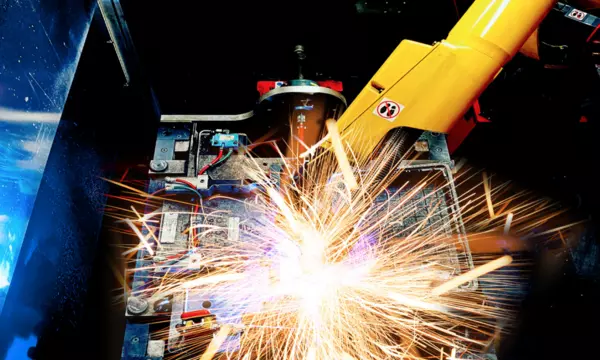Advanced Manufacturing Technology and Industry 4.0 Services
Advanced manufacturing technologies, or Industry 4.0, involves automating traditional manufacturing processes using technologies such as robotics, Internet of Things (IoT), big data analytics, artificial intelligence, and autonomous systems. Advanced manufacturing technologies can improve manufacturing capability and efficiency. The MEP National NetworkTM can help you with your Industry 4.0 strategy and implementation.
Implementing these technologies can help your company by:
- Optimizing processes
- Shortening cycle times
- Improving quality
- Reducing energy losses
- Shortening downtimes
- Improving overall equipment effectiveness
It can be easy to get overwhelmed by technology options and knowing where to start. The good news is that technology adoption isn’t all or nothing. The MEP National Network's manufacturing technology consulting services can show you low cost, easy-to-implement technologies that can drastically increase your productivity. With these, you can dip your toe into the world of Industry 4.0 and experience some of the benefits without major risks.
The MEP National Network will help you understand what technologies exists and if they are a good fit for your business. Our experts can help you establish an adoption strategy, scope the project, align suppliers with vetted resources and manage implementation to ensure your business goals and customer needs are met.
Augmented Reality and Virtual Reality
Augmented reality (AR) and virtual reality (VR) technologies create new ways of seeing and monitoring the plant floor. What’s the difference between AR and VR?
- AR superimposes computer-generated images onto your view of the world. You still see your surroundings, but extra information is incorporated into the real environment.
- VR completely immerses you in three-dimensional simulated environments that you can interact with in a seemingly real way. VR uses special electronic equipment, such as a helmet with a screen inside or gloves fitted with sensors.
How AR and VR can help small manufacturers:
- Providing comprehensive, immersive training applications. With VR and AR technologies, you can train employees to a standard of performance, quality and safety. The training can be repeated precisely, without change over time. This minimizes resource usage and results are tracked automatically. Using AR and VR can ensure your employees are properly trained to the same standard, easing knowledge transfer between employees. AR and VR also provide opportunities to practice different production scenarios that might arise so team members know how to handle a variety of challenges.
- Guiding workers through repair and operating processes. Companies can use AR and VR to regularly service equipment, without a training manual or parts catalog. With all information overlaid onto the machine through a simulation, workers can more easily and efficiently complete step-by-step instructions to repair, start up or shut down equipment. This can lower costs for manufacturers that invest excessive time into repairing equipment.
Big Data and Artificial Intelligence
Data should be a major consideration for your industry 4.0 strategy and implementation. Manufacturing facilities create an endless amount of data each day. Yet many manufacturers don’t know how to collect or use it. Big data refers to large data sets gathered from a range of business areas. Manufacturers can use big data to reveal patterns and trends in operations, especially relating to human behavior and interaction. In short, big data can help you make more informed, educated business decisions.
Big data and artificial intelligence (AI) are connected. Big data is what enables AI’s decision making. AI uses data from sensors, machines and people and then processes the information to make decisions without human intervention. It does so in a fraction of the time. The decisions made through the speed of AI can have significant impacts on production quality, capacity and waste.
How big data can help small manufacturers:
- Monitoring product quality and operations. Big data provides insight into every step of production. Through sensors attached to equipment, workers can see and respond to disruptions quickly – or even predict and prevent them. This ensures production runs efficiently and accurately. Increased awareness helps lower defects and unplanned machine downtime and it improves product quality. AI can further optimize processes since it analyzes data much quicker and more thoroughly. It also removes inconsistencies of human judgment about adjustments that need to be made.
- Driving continuous improvement. When gathering and analyzing supply chain data, weak spots quickly become apparent. With real-time data, your workers can quickly make changes that improve efficiency and quality – ultimately lowering defects and increasing profitability. Big data can drive strategic business decisions, providing a path forward to successful change.
- Enabling demand forecasting. Manufacturers can look back at historical data to identify trends in customer behavior and predict future demand. This helps manufacturers reduce stock levels and avoid shortages.
Robotics and Automation
In the increasingly competitive business landscape, manufacturers constantly look for ways to improve processes and boost their bottom line. Implementing robotics and automation in production enables many manufacturers to accomplish this goal. Using machines, robots and control systems to automate repetitive tasks makes your employees’ jobs easier. Combining high-quality results with employee engagement and cost savings makes automation an increasingly essential innovation, leading more manufacturers to build “smart” factories. The Network's manufacturing technology consulting services can help you identify opportunities in a vendor-neutral environment so you are not hit with a sales pitch from the start.
How robotics and automation can help small manufacturers:
- Improving efficiency and eliminating variation. Robotics and automation effectively eliminate variation in production and help reduce the time needed to complete tasks. With human error and variation removed from certain parts of production, quality and efficiency will boom. These improvements translate into huge cost savings for manufacturers.
- Increasing safety. Many manufacturing environments involve potential safety issues for workers such as dangerous machinery, heavy lifting or toxic chemicals. Robots placed in these positions remove the risk of human error, increasing quality and safety – and enabling employees to move into safer roles.
- Allowing for greater employee development. Removing your workers from harmful environments enables them to take on new, more advanced tasks. Automating simple, manual tasks frees your employees for other positions – helping alleviate the current talent shortage in manufacturing. At the same time, automation supports your employee retention efforts. By providing workers with skills training and growth opportunities you’ll increase their engagement and loyalty to your organization.
Additive Manufacturing
Additive manufacturing, also known as 3D printing, is the practice of adding layers of material (such as plastic, metal, concrete or wood) on top of each other to create a product. Due to its many applications – rapid prototyping, repairs, waste reduction, flexible innovation – additive manufacturing has grown quickly in popularity.
How additive manufacturing can help small manufacturers:
- Providing tooling opportunities. With 3D printing, manufacturers create tools that would be impossible or too expensive to make with traditional methods. Because of the layering process, 3D-printed parts can be stronger, more durable and higher quality overall. Additive manufacturing also minimizes waste. Additive uses only the material needed, without the excess material removed in traditional, subtractive manufacturing.
- Allowing for quicker repairs. The speed and flexibility of additive manufacturing allow manufacturers to efficiently replace old or broken machinery parts. Rather than going to an outside distributor for repairs, all parts can be created in house for quicker and easier replacements. This flexibility also enables you to add to existing parts to extend their life or create new use cases.
- Improving the prototype process. In the past, long lead times for prototyping held many manufacturers back from investing in innovation. With 3D printing, that’s no longer the case – you can test a design’s functionality without waiting weeks for it to be produced using traditional methods. Most 3D printers can print parts in just hours, rather than weeks or months. 3D printing enables greater flexibility and production innovation, as you can efficiently test new products and make changes before committing to a design.
Simulation
Production processes and parts designs can always be improved. Manufacturers face the challenge of figuring out what to change to get the best results. Simulation software assists with this process. Using simulations, you can create virtual representations of a part or process. You can then validate improvement ideas without incurring a huge expense up front – and without impacting current production.
How simulation can help small manufacturers:
- Making improvements in the facility, without moving heavy machinery. With simulation, you don’t have to move heavy equipment or disrupt production. Instead, with simulation software you can virtually test out different facility layouts to determine which is optimal. Real-world conditions can also be tested. You can simulate possible production situations and analyze how they would unfold.
- Enhancing overall production effectiveness. Once you’ve reorganized equipment according to the simulation to optimize processes, you’ll quickly notice improvements in lead times, productivity and waste. These advancements would otherwise have taken much more time and expense – or been impossible without the help of simulation.
- Testing new parts before making investments. Similar to 3D printing, simulation allows you to develop and perfect designs for new parts before investing. This results in cost savings, and provides higher confidence and quality in designs.
System integration
Gathering and analyzing data is easier than ever. System integration involves business management software like enterprise resource planning (ERP) systems. An ERP enables you to collect, store, manage and understand data from a variety of areas in your business. This centralized location for your organization’s data makes for more efficient data management and increased transparency into business operations. System integration delivers information to those who need it, where and when they need it.
How system integration can help small manufacturers:
- Providing one centralized location for data collection. Many manufacturers don’t collect data at all. Or they collect it, but aren’t sure how to use it. System integration solves these issues by providing a unified source of data, enabling you to see all your collected data in one place. From there, data can more easily be compared and analyzed to inform strategic decision-making.
- Improving visibility into the company’s planning, scheduling and performance. Data collection and broad company strategy are often forgotten in the busy day-to-day manufacturing environment. With system integration, you can quickly receive information from all levels of business operations. This helps you maintain a proper balance between daily management and driving future initiatives. Companywide data automatically gathered and presented by the software empowers you to identify areas to improve and set realistic goals for future performance.
Cloud Computing
Trying to find the right piece of information when you need it can be like finding a needle in a haystack. This can have serious consequences for manufacturers – putting quality, safety or productivity in jeopardy. Cloud computing eliminates these risks.
Cloud computing involves storing and accessing data and software applications through internet connectivity. This provides a faster, safer and more efficient way to locate company information. With all data in one convenient place, you can find exactly what you need, when you need it.
How cloud computing can help small manufacturers:
- Allowing for quicker, easier access to information. Companies that transfer all data storage to the cloud can instantly access any type of information, whenever it’s needed. With data in one digital location, employees can easily find what they need without sorting through endless physical records. Speeding up this process enables your workers to spend more time focusing on larger business goals.
- Empowering greater collaboration. Cloud-based data storage greatly increases your ability to collaborate. Workers in different locations or departments can more easily collaborate when they’re all using a single cloud-based data center.
Internet of Things
Internet of Things (IoT) involves using sensors and communications technology to collect and share data that can improve operations. With increased interconnectivity, your company can monitor real-time performance to create an environment of complete visibility and productivity.
How IoT can help small manufacturers:
- Providing real-time visibility into operations. How effective are your processes? When is your next machine going to break down? Where are most defects coming from? These questions and more can be answered with IoT. Sensors in your facility can communicate key information about your operations directly to workers, in the moment. Sensor data gives you greater insight into various production elements. It enables you to predict machine breakdowns, locate bottlenecks and identify production areas that can be improved.
- Optimizing performance. This insightful data enables you to respond to production issues, minimizing or avoiding negative impacts. Preventive maintenance becomes predictive maintenance, allowing for scheduled downtime to maximize production. Your organization can achieve new levels of productivity with tools that help you use resources more efficiently, improve workplace safety and optimize production quality.
Cybersecurity
Unfortunately, the risk of cyberattack rises with increased interconnectivity. Electronic data collection, storage and transmission increase these risks. As companies adopt Industry 4.0 technologies, more are targeted for cybertheft, damage or disruption. The importance of cybersecurity cannot be ignored.
Cybersecurity includes all measures to protect a company from the unauthorized use of electronic data. By safeguarding all hardware, software and information from internal and external threats, manufacturers can stay protected and prosperous while capitalizing on the benefits of the Internet of Things, interconnectivity and other technologies.
How cybersecurity can help small manufacturers:
- Protecting your data. The first step is to understand risks to your data. This involves identifying valuable company information and locating weak points in your systems’ security. Potential breaches can then be predicted – or prevented.
- Increasing your ability to detect, react and recover. An incident response plan enables you to deal with various types of cyberattack, such as malware, phishing or social engineering. Having a plan in place heightens your company’s chance of surviving these attacks. Each technology carries different risks, so it’s important to think through the details of response plans before an attack.
- Boosting your competitive advantage. As data breaches increase, companies want to do business with other companies that protect themselves. Getting and keeping their business may depend on providing assurances that your company takes cybersecurity seriously and can be trusted to keep their information safe.
Employees often think robots will replace jobs, but that’s not even close to what we're looking to do. We want to utilize the robot to help our people become efficient and enjoy their work more – shifting the tasks they don’t enjoy as much to the robot and giving them more opportunities to do what they like doing.
—Hans Haase, ESI Manufacturing Engineer, Electronic Systems Inc.
Read the Success Story
Articles on Advanced Manufacturing Technology and Industry 4.0 by MEP National Network Experts
- Revolutionizing American Manufacturing
- FastLane Helps Triangle Precision Increase Capacity With Automation
- Infographic – Integrating Cybersecurity With Industry 4.0: What It Means for Manufacturing
- Cybersecurity Risk Mitigation for Small Manufacturers
For more information or assistance with advanced manufacturing technologies or Industry 4.0, please contact your local MEP Center.
If you would like someone to contact you about advanced manufacturing technologies or Industry 4.0, please complete the form below.
Contacts
For General Information
-
MEP Headquarters(301) 975-5020100 Bureau Drive, M/S 4800
Gaithersburg, MD 20899-4800





